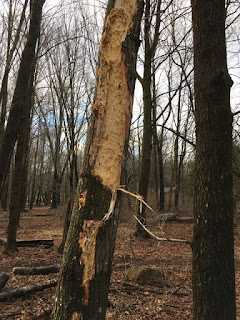What follows is a photo essay compiled by Carrie Crompton of Andover, CT Master Naturalist apprentice, illustrating the feeding behavior of Pileated woodpeckers.
~~~~~~~~~~~~~~~~~~~~~~~
Pileated Woodpeckers have been stripping this dead Populus grandidentata, commonly called large-tooth aspen, big-tooth aspen, American aspen, or white poplar, all winter.
As they excavate insect galleries in the punky wood, they throw the strips of wood to the ground.
One afternoon in January 2018, I discovered a female Pileated at work (19-second video).
What is she after? Carpenter ants. Pileated woodpeckers favorite food is carpenter ants, but they eat many other insects, and wild fruits and nuts as well.
Carpenter ants do not consume wood — they simply use it as structural material for their nests. They chew up soft, wet wood with their mandibles and remove it from the galleries as they create them. Often, you can tell carpenter ants are at work when you see a pile of “sawdust” at the base of a hollowed-out tree. They are not responsible for the death of the wood — they are simply clearing out what is already dead.
 |
| "Sawdust" created by carpenter ants. |
Do Pileateds use the same visual clue that I have -- sawdust at the base of the tree -- to infer the presence of carpenter ants? Or do they use other clues — sounds or smells for example — to detect carpenter ants beneath the bark of a snag? I do not know.





No comments:
Post a Comment